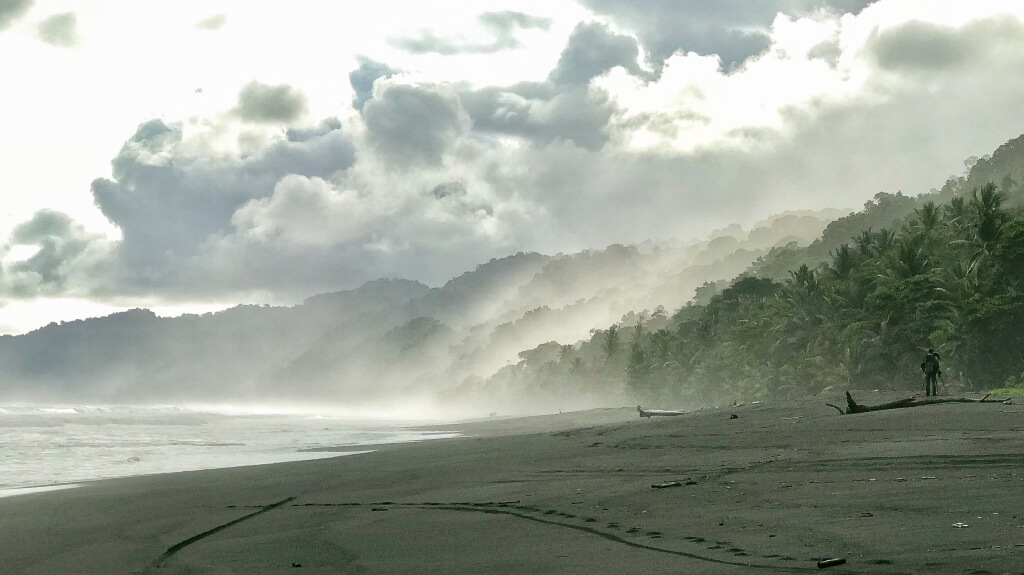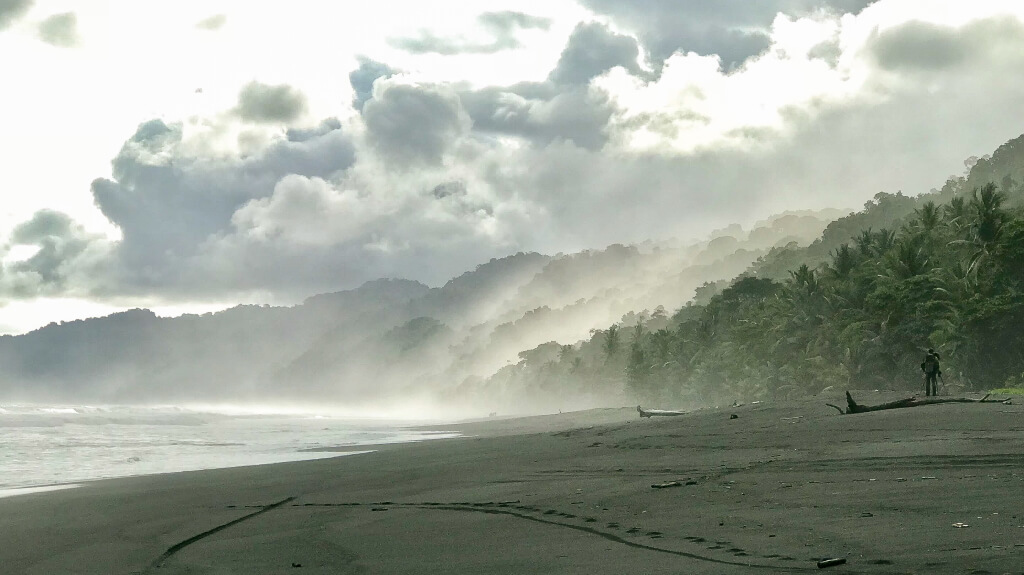
How to visit the Corcovado National Park
How to visit the Corcovado National Park Our guide and advice for visiting Corcovado National Park Corcovado National Park is considered one of the most

Corcovado National Park is considered one of the most beautiful national parks in the world. It was presented by the National Geographic as “the most biologically intense place on Earth” with over 2.5% of the world’s biodiversity. The biodiversity of Osa is not surpassed by any region of similar size anywhere on earth.
The forest of the park and the Peninsula is one of the largest primary forests on the Pacific coast of the American continent. With 42,770 hectares (plus 5,000 maritime) and 39 km of beach, it covers almost half of the Peninsula (48%).
It was created, in a courageous and visionary way, in 1975, to protect this area from forest exploitation and gold mining. The creation of the park was the first act of a very proactive environmental protection policy.
The corcovado in numbers
8 types of habitat are listed in the park and 13 different ecosystems (lowland rainforest, upland cloud forest, jolillo palm forest, mangroves, coastal and marine habitats). It is home to over 15,000 species of plants, 500 species of trees. The park is home to 124 species of mammals, 375 species of birds including 16 hummingbirds and the largest number of scarlet macaws in Central America, 71 reptiles, 46 amphibians, 40 species of freshwater fish and 8,000 insects, the 4 species of marine turtles that come to Costa Rica to nest, the 4 species of monkeys and six species of felines present in Costa Rica
It is the ideal place to observe the most endangered species of the country, such as the Baird’s Tapir (Danta), the Red Macaw, the Red-backed Squirrel Monkey (or tití) and the White-lipped Peccary, the Jaguar…
There are several entries. Each one with its own specificities and, above all, different means of access.
La Leona Station (Carate)
This is the main entrance to the park.
From the station, you will walk along a path that runs along the beach and through a secondary forest. In one day, you will make a return trip on the same trail. This trail does not allow you to discover the primary forest but it is very accessible with almost no elevation change.
From this station, you can go to the next station (La Sirena) which is 20 km away, have dinner, sleep and breakfast at the station and come back to La Leona the next day or go back to Los Patos station.
Access to Carate from Puerto Jimenez by private car (4×4 essential / About 2 hours of track), by cab ($160 round trip), by mini-bus ($30 round trip) or by colectivo ($10).
Access to La Leona resort is by foot from the village of Carate via Madrigal beach (3 km).
Los Patos Station (La Palma).
The path is quite difficult (steep at the beginning). It crosses a superb primary forest. It is possible to refresh yourself in a waterfall or in the river. The station is very difficult to access in winter and the path can be very muddy. It is often closed at this time.
Access from La Palma by private car (difficult especially in winter) or by cab ($60 from La Palma and $90 from Puerto Jimenez).
It is also possible to get there by walking from Guadalupe on the Rincón river (10 km) or by the La Tarde road (7 km)
La Sirena Station
This is certainly the area where it is easiest to see animals. It is also the most frequented. There are several paths that start from the station.
The access is done by walking from the areas of La Leona (20 km) or Los Patos (25 km). In this case, you will have to sleep at the resort.
You can also access it by boat from Bahía Drake, Sierpe or Puerto Jiménez.
El Tigre Trail (Dos Brazos.
The trail is a 7.5 km loop, quite difficult for the first 3 km. It is possible to see animals if you start very early in the morning. The circuit crosses a superb primary forest. The tours are organized by the Dos Brazos Development Association. The guides are often former gold diggers who know the forest and its secrets perfectly.
The entrance to the trail is in the middle of the village of Dos Brazos, about 30 minutes by car from Puerto Jimenez.
San Pedrillo Station
The entrance by San Pedrillo is the least frequented. It is often closed. It is accessible by foot from Drake by a path of about 14/15 km along the coast or by boat from Bahia Drak
In theory, you can visit the park without a guide if you spend only one day there (except for the El Tigre Trail for which a guide is mandatory).
It is complicated to book the entrance to the Corcovado without a guide and some captains, including those of Puerto Jimenez, refuse to transport visitors without guides.
I recommend the use of a guide. Your visit will be safer and more interesting. Without a guide, you may miss a lot. In addition, by using the services of a guide and/or an agency you support the local economy.
Check that the guide is certified. Since entry into the park is possible without a guide for day trips, a “guide” without certification and insurance may accompany you.
In one day, it is possible to make a round trip around La Leona, La Sirena (an excellent option to reach the heart of the park), Los Patos or to do the El Tigre trail at Dos Brazos.
In two or three days and one or two nights, you can enter through La Leona, Los Patos and spend one or two nights at La Sirena (the only lodging site in the park) and then retrace your steps or exit through the other station. You can also come and go from the Station by boat.
It is forbidden to bring food into the park. However, it is recommended to bring water that is not in a plastic bottle .
You can bring a snack to eat on the boat on your way to or from the park.
For day tours, lunch at the Station is included.
For two or three days tours, all meals are included in the package and will be taken at the Station restaurant. Meals are simple but hearty and good.
The climate is hot and humid all year round.
The dry season is from December to the end of April but it is also the most touristic season. It is more pleasant to hike during the dry season, but the animals are more visible and the vegetation more lush during the rainy season from May to the end of November.
It is best to avoid the October and November period. The rains can be permanent and torrential. During this period parts of the park may be inaccessible and often the park itself is completely closed.
The main dangers you may encounter in Corcovado are snakes, mosquitoes, horseflies, spiders, crocodiles… coconuts…, You must take care to the sun and river crossings especially at the estuaries…
Reservations are mandatory. At certain times of the year, especially during the high season, it is essential to book in advance, especially for stays of more than one day.
The number of entries in the park is limited as well as the number of passengers in the boat coming from Puerto Jimenez. There are enough providers in Bahia Drake to respond to the demand.
You can do this through the park offices next to the airport in Puerto Jimenez and the ADI association for accommodation and catering. Nevertheless, the process is a bit complicated. You must first reserve at the park office for the entrance and then go to the Banco National to pay, find a guide, possibly book accommodation in another organization …
The easiest solution is to use an agency that will make the reservation for you and that will guarantee you a quality service.
For any reservation, you will have to provide a photocopy of the passport of all participants.
Reservation packages (guide, entrance, transfer, accommodation)
Reservation for entrance to the park
Reservation for food and lodging in the park

How to visit the Corcovado National Park Our guide and advice for visiting Corcovado National Park Corcovado National Park is considered one of the most

5 ways to discover the rainforest differently 5 ways to discover the rainforest differently The Osa Peninsula is mainly made up of the largest tropical
Post Discussion